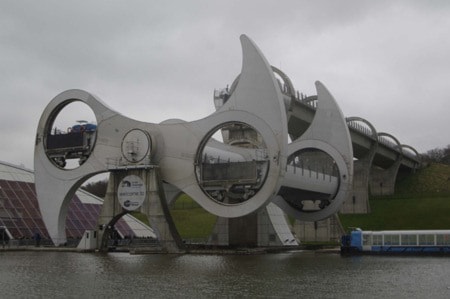Meridian Writers’ Group
FALKIRK, Scotland — Scotland has long been famous for engineering genius, its roving sons building the world’s bridges, railways and steamships from the Victorian era onwards.
So it is perhaps only appropriate that a fine piece of 21st-century engineering has become one of Scotland’s most popular tourist attractions.
Towards the end of the 18th century the completion of a 56-kilometre-long canal, the Forth & Clyde, allowed ocean-going trading vessels to sail right into Glasgow. Subsequently, when the Union Canal opened in 1822, this connection was extended to Edinburgh, completing a Scottish Lowlands waterway network.
But in 1933 the vital, 11-lock link that joined the two canals was cut by road construction, leaving two separate routes, one 35 metres above the other. In the decades that followed, both were largely abandoned and forgotten.
Now, revived for pleasure boating (along with much of Britain’s extensive, 18th- and 19th-century canal network), the two have been reconnected with the world’s only rotating boat lift: a vast, cog-covered mechanical beast that scoops up boats and water and sends them arcing through the air on the mother of all Ferris wheel rides.
The ride didn’t come cheap. The highway project that originally severed the canal only saved £16,000 by taking the shorter route through the locks. The revival of the waterway, completed in 2002, cost £84.5 million, of which 20 per cent was spent on the reconnection itself.
In the new alignment the final bit of the upper canal, before it reaches the Falkirk Wheel, soars over the valley on a series of pylons, passing like a thread through the concrete rings that top each support. Beyond the last ring is the wheel. There is more than a small element of science fiction in its design, and yet just beyond lie some traditional locks with creaking wooden gates: the overall effect is Klingon Empire meets Wind in the Willows.
To the onlooker, a ship entering the wheel’s upper gondola seems ready to glide straight on and plunge into the water below. But it halts, and barriers rise behind it. There’s a 20-second delay while 240 sensor checks are carried out by computer, then the structure begins, ponderously but magnificently, to rotate. The speed is impressive, if not exactly the “white-knuckle ride” promised in some of the literature. More impressively still, the system is so perfectly balanced that the energy needed for a single rotation is no more than that required to boil eight kettles.
Unlike with traditional locks, no water is lost, since as much is carried up with each rotation as travels down, and the journey time is in minutes rather than the hours it sometimes took to descend the original 11 locks, especially at peak season.
There’s no charge for taking a boat up or down, but if you haven’t brought your own vessel you can pay to take one of the frequent cruises on offer at the visitor centre, which sits at the base of the wheel and whose glass wall offers panoramic views of this unique engineering marvel at work.
Access
For more information on the Falkirk Wheel visit its website at www.thefalkirkwheel.co.uk.
For information on travel in Scotland visit the Scottish Tourist Board website at www.visitscotland.com.
